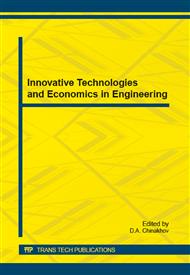p.202
p.206
p.210
p.216
p.224
p.231
p.236
p.240
p.246
Research of Operational Characterizations of Cutting Discs with Oriented Abrasive Grains
Abstract:
Efficiency of the polishing process is determined by the properties of abrasive grains, including its form parameter and orientation in the body of the grinding tool. It is possible to improve the operational characterizations of the grinding instruments, in particular – cutting discs, by ordering of the grain geometry, selection of the rational form and orientation of abrasive grains for specific processing conditions and parameters of the power load. For the solution of such problem the developed and patented method for production of grinding tools with the orientated abrasive grains is offered [1]. According to the specified method the cutting discs with radial and tangential orientation of abrasive grains are made. As a comparative standard, discs without orientation of abrasive grains are made also. Comparative tests by cutting according to the scheme of pressing of workpiece to a disc with a constant effort are carried out. It is established that orientation of abrasive grains significantly influences the operational characterizations of cutting discs. So, the cutting ability of cutting discs with radial orientation of abrasive grains is 15-17% higher during processing of various materials, than at standard tools. The grinding coefficient of cutting discs with tangential orientation of abrasive grains is 25-29% higher, than at usual discs with non-oriented grains. Results of an assessment of effective power of cutting in addition confirm that discs with the radial orientation of grains are working with the greatest intensity and at the same time with biggest wear. Further, on decrease, cutting discs with non-oriented grains follow. Instruments with tangential orientation of abrasive grains are characterized by the smallest cutting ability and the smallest wear. Such effect is caused by that the radial focused abrasive grains possess the greatest sizes of forward corners, and tangential focused grains possess the smallest sizes. It is established also that application of cutting discs with radial orientation of abrasive grains in comparison with ordinary tools allows to reduce temperature in a cutting zone by 20-30 °C and to reduce the size of zones of thermal influence.
Info:
Periodical:
Pages:
224-230
Citation:
Online since:
October 2014
Authors:
Price:
Сopyright:
© 2014 Trans Tech Publications Ltd. All Rights Reserved
Share:
Citation:


